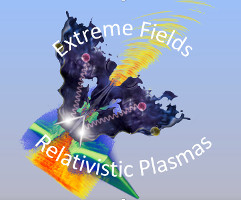
Posted: 4/19/16
Author: M. Hegelich, L. Labun
Topic: Quantum Dynamics
Quantum Effects in Strong Classical Potentials
- What to do with Multi-Petawatt lasers
Currently there are no successful non-perturbative, dynamic quantum field theories, and such theories are necessary to calculate quantum effects in the presence of strong classical potentials. Important problems involving strong classical potentials are found in many areas of physics including Quantum Electrodynamics, Quantum Chromodynamics and Gravity. Example problems include: determining the Parton distribution function (i.e., the distribution of Quarks and Gluons in a proton), modeling the transition of colliding hadrons to a Quark-Gluon-Plasma (QGP), or describing particle creation in the vicinity of a black hole, electron motion and radiation emission in the magnetic field of a neutron star, and spontaneous pair creation from the quantum vacuum in the presence of a strong electromagnetic field. Developing and testing a theory in one sub-field, e.g. QED, allows the methods employed in that theory to be transferred to other fields.
An ultra-intense laser can be used to test a non-perturbative quantum field theory in the QED context. A 100-PW laser can create ultrastrong fields of >>1015 V/m to form a strong classical potential for QED processes. Moreover, it can create this potential in a controlled fashion, allowing testing of the theory over a range of parameters.
We are developing such a dynamical quantum field theory based on the hierarchical separation of scales. To fully test spontaneous pair creation we require a laser capable of producing on-target intensities of 1024 - 1025 W/cm2, i.e. a 100 PW class machine. On the way to describing spontaneous pair creation, we will encounter several additional challenges of classical and quantum particle dynamics in strong fields, including classical radiation reaction, quantum radiation, and the need for a quantum kinetic theory. Those effects can be observed at lower field strength (~1014 - 1015 V/m) and with smaller lasers, allowing a first experimental test of initial theories and validation of computer models with on-target intensities of 1022 - 1023 W/cm2. To enable first experiments, we are upgrading the achievable Texas Petawatt Laser intensity to >3x1022 W/cm2 and its contrast sufficient to limit preplasma effects. I will discuss first experiments for this system as well as for the upcoming 5PW OPCPA laser at SIOM. These experiments are a first step across the threshold of nonlinear QED and will pave the way for future work on stronger lasers, which will more fully explore the regime of non-perturbative, dynamic quantum field theories.
Once QED contributions are well understood, any observed deviations from them indicate an effect outside of QED, which would motivate searches for axion-like pseudo-scalar and light scalar particles that also couple to gravity. Coupling to gravity would be indicated if we see experimentally that particles accelerated strongly in an EM field have a horizon, thus building a bridge to quantum effects in strong gravity fields as found around black holes. Since these effects would manifest themselves in experiments as fluctuations on a QED background, it is imperative to develop first a complete understanding of the QED case.